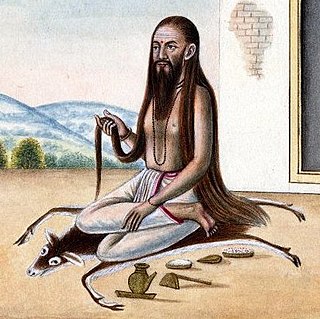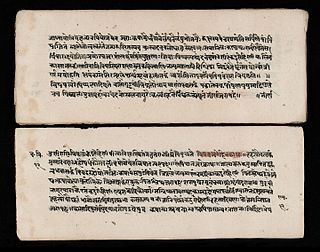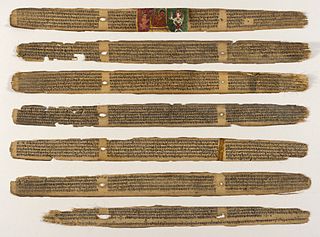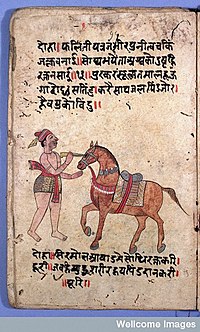
Bharadvaja was one of the revered Vedic sages (maharishi) in Ancient India. He was a renowned scholar, economist, grammarian, physician and a follower of Maha Pashupata. He is one of the Saptarishis.

Ayurveda is an alternative medicine system with historical roots in the Indian subcontinent. It is heavily practiced in India and Nepal, where around 80% of the population report using ayurveda. The theory and practice of ayurveda is pseudoscientific.

Charaka was one of the principal contributors to Ayurveda, a system of medicine and lifestyle developed in ancient India. He is known as a physician who edited the medical treatise entitled Charaka Samhita, one of the foundational texts of classical Indian medicine and Ayurveda, included under Brhat-Trayi.

Traditional medicine comprises medical aspects of traditional knowledge that developed over generations within the folk beliefs of various societies, including indigenous peoples, before the era of modern medicine. The World Health Organization (WHO) defines traditional medicine as "the sum total of the knowledge, skills, and practices based on the theories, beliefs, and experiences indigenous to different cultures, whether explicable or not, used in the maintenance of health as well as in the prevention, diagnosis, improvement and treatment of physical and mental illness". Traditional medicine is often contrasted with scientific medicine.

In the history of medicine, "Islamic medicine" Also known as "Arabian medicine" is the science of medicine developed in the Middle East, and usually written in Arabic, the lingua franca of Islamic civilization.
Agnivesha is a legendary rishi (sage) in Hinduism, reputedly one of the earliest authors on Ayurveda. He is described to have codified the knowledge of his preceptor, Atreya, and arranged it in the form of a treatise, named the Charaka Samhita.

Medical literature is the scientific literature of medicine: articles in journals and texts in books devoted to the field of medicine. Many references to the medical literature include the health care literature generally, including that of dentistry, veterinary medicine, pharmacy, nursing, and the allied health professions.

The Charaka Samhita is a Sanskrit text on Ayurveda. Along with the Sushruta Samhita, it is one of the two foundational texts of this field that have survived from ancient India. It is one of the three works that constitute the Brhat Trayi.

The Sushruta Samhita is an ancient Sanskrit text on medicine and surgery, and one of the most important such treatises on this subject to survive from the ancient world. The Compendium of Suśruta is one of the foundational texts of Ayurveda, alongside the Charaka-Saṃhitā, the Bhela-Saṃhitā, and the medical portions of the Bower Manuscript. It is one of the two foundational Hindu texts on the medical profession that have survived from ancient India.
The Bṛhat-Trayī, literally translated as "The Great Triad ", refers to three early Sanskrit encyclopaedias of medicine, which are the core texts of the indigenous Indian medical system of Ayurveda. These are contrasted with the Laghu-Trayī or the "lesser triad", a secondary set of later authoritative compositions.
Kashyap Samhitā, also known as Vriddha Jivakiya Tantra is a treatise on Ayurveda attributed to the sage Kashyapa.

Sushruta is the listed author of the Sushruta Samhita, a treatise considered to be one of the most important surviving ancient treatises on medicine and is considered a foundational text of Ayurveda. The treatise addresses all aspects of general medicine, but the impressive chapters on surgery have led to the false impression that this is its main topic. The translator G. D. Singhal dubbed Suśruta "the father of plastic surgery" on account of these detailed accounts of surgery.
Atreya (आत्रेय) Rishi, or Atreya Punarvasu, was a descendant of Atri, one of the great Hindu sages (rishis) whose accomplishments are detailed in the Puranas. Sage Atreya was a renowned scholar of Ayurveda, and a school of early Ayurveda was founded based on his teachings.
The Mānasollāsa also known as Abhilashitartha Chintamani, is an early 12th-century Sanskrit text composed by the Kalyani Chalukya king Someshvara III, who ruled in present-day Karnataka. It is an encyclopedic work covering topics such as polity, governance, ethics, economics, astronomy, astrology, rhetoric, veterinary medicine, horticulture, perfumes, food, architecture, games, painting, poetry, dance and music. The text is a valuable source of socio-cultural information on 11th- and 12th-century India.
There was, for a considerable period of time, a very lively and extensively practiced tradition of formal debates in ancient India. These debates were conducted, sometimes with royal patronage, to examine various religious, philosophical, moral and doctrinal issues. The corpus of knowledge on conducting a successful debate was referred to as vādavidyā and several manuals dealing with this discipline had been produced. It was from these debates that the Indian tradition of logic and allied investigations were evolved and developed. The antiquity of this tradition can be traced even to pre-Buddhist period. For example, Brhadaranyaka Upsanisad, a pre-Buddhist text, has references to King Janaka as not only organizing and patronizing debates between the sages and priests but also as participating in such debates. Women also used to participate in these debates. Gargi was a woman scholar who used to participate in the debates in King Janaka's court.
Satya Narayana Shastri was an Indian physician of Ayurveda and a Sanskrit scholar. Born in 1887 in the Indian state of Uttar Pradesh, he was the first honorary physician to Rajendra Prasad, the first president of India. He wrote the introduction of Charaka Samhita, when it was published in 1962. He served as the principal of Ayurveda College of Banaras Hindu University and Government Ayurveda College of Sampurnanand Sanskrit Vishwavidyalaya. The Government of India awarded him Padma Bhushan, the third highest Indian civilian award, in 1954.
Chakrapani Datta was a Bengali scholar and practitioner of Ayurveda medicine.
Charaka shapath is a certain passage of text in Charaka Samhita, a Sanskrit text on Ayurveda believed to have been composed between 100 BCE and 200 CE. The passage referred to as Charaka Shapath is written in the form a set of instructions by a teacher to prospective students of the science of medicine. According to Charaka Samhita, the unconditional agreement to abide by these instructions is a necessary precondition to be eligible to be taught in the science of medicine. The passage gives explicit instructions on the necessity of practicing asceticism during student life, student-teacher relationship, the importance of committing oneself fully and completely for the well-being of the patient, whom to treat, how to behave with women, and several other related issues. The passage appears as paragraphs 13–14 in Chapter 8 of the Vimanasthana in Charaka Samhita.
Bhela Samhita is a Sanskrit-language medical text from ancient India. It is known from an incomplete c. 1650 CE manuscript kept at the Sarasvati Mahal Library in Thanjavur, and a c. 9th century fragment found at Tuyoq. Quotations in other works suggest that an older version of the text, possibly composed during 400-750 CE, existed.










